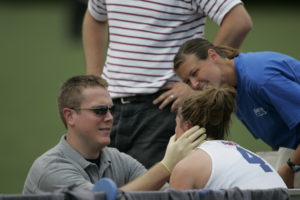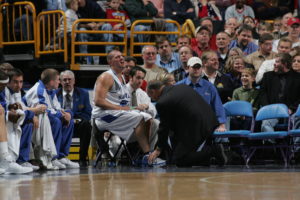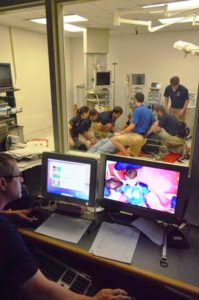 Written by Dr Anthony Breitbach PhD ATC, Associate Professor and Director of the Athletic Training Program in the Doisy College of Health Sciences at Saint Louis University @SLU_AT
Written by Dr Anthony Breitbach PhD ATC, Associate Professor and Director of the Athletic Training Program in the Doisy College of Health Sciences at Saint Louis University @SLU_AT
Teamwork and collaboration are highly valued in athletics, but what about with the health professionals who care for the athletes? I have had the opportunity to study this relationship recently with UK colleagues. We found that collaboration in sports medicine is heavily dependent on the context of the sport organizations and institutions that hosts the athletic endeavors.

Saint Louis University physician and athletic trainer managing a facial injury incurred in field hockey
With Dr. Simon Fletcher and Professor Scott Reeves I collaborated on two projects: a scoping review of Interprofessional Collaboration in Sports Medicine (Fletcher, Breitbach, & Reeves, 2017) and a research project at the All Together Better Health VIII (ATBH VIII) Conference at Oxford, UK, September 2016. The research project consisted of a consensus event utilizing the World Café’ method at ATBH VIII entitled, “Utilizing Sport to Study and Improve Global Interprofessional Collaborative Health Care (Breitbach, Reeves, Fletcher, 2017).
We found that there are several unique factors that influence interprofessional collaborative practice (IPCP) in sports medicine. The following themes were identified in the scoping review:
- Professionalization: Formal processes that connect health professionals to an athletic organization compromise the influence of these practitioners, who are often met with more resistance than they would be if they remained casual team members. Status as a provider for a high profile athletic organization can be tied to factors other than traditional medical qualifications and relationships.
- Professional dominance: Disparities in power and status between disciplines where there may be inequities that do not occur in traditional healthcare (i.e. coaches vs physicians). There are efforts in the USA where athletic trainers move from an “athletic model”, where the sports medicine staff reports to athletic administrators, to a “patient-centered medical model” where the sports medicine staff exist within a more traditional medical organization. (Laursen, 2010)
- Status imbalances: Difficulties which face professionals who are required to adopt new roles of diminished prestige as compared to their role in the traditional healthcare system. Hierarchies that exist in traditional healthcare settings often do not occur in the same way in athletic organizations.
- Interprofessional negotiation: The adaptability of sports medicine practitioners in sports medicine when previous perceptions around status and knowledge are realigned. This is important in times of conflict where participation decisions can be affected by other stakeholders such as coaches, managers, administrators or sports agents. A prime example of this conflict has been reported in the management of sport concussion. (Kroshus et al., 2015)
- Confidentiality: Medical training, codes of ethics and regulation (i.e. HIPAA) consider the confidentiality of the patient sacrosanct, but an athletic context disrupts this, as a range of interested parties expect to be kept fully informed about the athletes’ wellbeing. Additionally, there is a relative lack of guidelines or ruling around this issue in professional sport.
- Compromise and competition: Professional adaptation of sports medicine practitioners, where competition exists centering around diagnoses, context and athlete/doctor negotiation, placing sports medicine practitioners in a culture which forces various professional disciplines to operate in proximity but discourages interprofessional collaboration.

Dr. Breitbach assessing injury during a Saint Louis University Men’s Basketball game
In the World Café study, we examined how the teamwork principles of sports can advise how health professionals collaborate in the greater healthcare setting. Detail about the execution of the World Café’ is available in an earlier blog post (A. P. Breitbach, 2016). In the consensus event, we asked the participants to discuss a different question in each round: (1) “What key features of collaboration, which are emphasized in sport, can be applied to health care?” (2) “What barriers exist to the inclusion of these features in health care?” (3) “How can Interprofessional Collaborative Practice improve sports and exercise medicine at and away from the field/pitch?”
The conversations were captured, transcribed and deidentified prior to qualitative analysis. Excerpts were coded using the four Interprofessional Education Collaborative (IPEC) competency domains and either an extrapersonal or interpersonal locus. In question 1 the conversation themes focused on structural and extrapersonal factors as strategies that can improve IPCP. Athletic teams feature well defined leadership, structured and explicit hierarchies, as well as dedicated time and space to practice teamwork. The IPEC domains of: Roles and Responsibilities; and Teams and Teamwork occurred more frequently in the Question 1 conversations.
The conversations at the tables in Question 2 had a more interpersonal locus where the IPEC domains of Values/Ethics for Interprofessional Practice and Interprofessional Communication occur more often. These barriers that are harder to control through structure and both healthcare and athletics have them in common. Strong communication and culture are characteristics of high performing teams, regardless of the context.
Participants had difficulty with Question 3 for several stated reasons. One of these reasons was that professionals outside the USA look at athletic organizations differently than those in the USA where organized athletics occur regularly in secondary schools, colleges and universities. Additionally, there were no athletic trainers represented among the participants at ATBH VIII, whose perspective may have helped inform the conversations.

Saint Louis University students prepare for management of an on-field injury in clinical simulation center
Momentum for IPCP in athletic training is growing, but recent studies show that there is much work needed. For example, a project by Eliot et al (Eliot, Breitbach, Wilson, & Chushak, 2017) found that about 38% of all athletic training programs in the US who responded to a survey included interprofessional education in their curricula. Similarly, Hankemeier & Manspeaker (Hankemeier, 2017) reported that 47% of athletic trainers who responded to a survey about IPCP indicated that “their patient care occurred in an interprofessional manner”.
In summary, in both our projects, we found that the structure of athletics highly influences sports medicine and can help inform interprofessional collaboration and teamwork in healthcare. However, factors with a more interpersonal locus such as communication, status or culture are barriers common to athletics and healthcare.
REFERENCES
Breitbach, Reeves, Fletcher. (2017). Health Care as a Team Sport? Studying Athletics to Improve Interprofessional Collaboration in submission.
Breitbach, A. P. (2016). Capturing Interprofessional Conference Conversations Using a World Café Approach. Retrieved from http://jicareblog.org/blog-article-capturing-interprofessional-conference-conversations-using-a-world-cafe-approach/
Eliot, K., Breitbach, A., Wilson, M., & Chushak, M. (2017). Institutional Readiness for Interprofessional Education Among Nutrition and Dietetics and Athletic Training Education Programs. Journal of Allied Health, 46(2), 94-103.
Fletcher, S., Breitbach, A. P., & Reeves, S. (2017). Interprofessional Collaboration in Sports Medicine: Findings from a Scoping Review. Health & Interprofessional Practice, 3(2), eP1128. doi:10.7710/2159-1253.1128
Hankemeier, D. A., Manspeaker, S.A. (2017). Athletic Trainers’ Perceptions of Interprofessional and Collaborative Practice. Athletic Training and Sports Health Care. doi:10.3928/19425864-20170612-01
Kroshus, E., Baugh, C. M., Daneshvar, D. H., Stamm, J. M., Laursen, R. M., & Austin, S. B. (2015). Pressure on Sports Medicine Clinicians to Prematurely Return Collegiate Athletes to Play After Concussion. Journal of Athletic Training, 50(9), 944-951. doi:10.4085/1062-6050-50.6.03
Laursen, R. M. (2010). A Patient-Centered Model for Delivery of Athletic Training Services. Athletic Therapy Today, 15(3), 1-3. doi:10.1123/att.15.3.1